Samsung Galaxy Z Flip 5 vs Motorola Razr+: Which foldable phone wins?
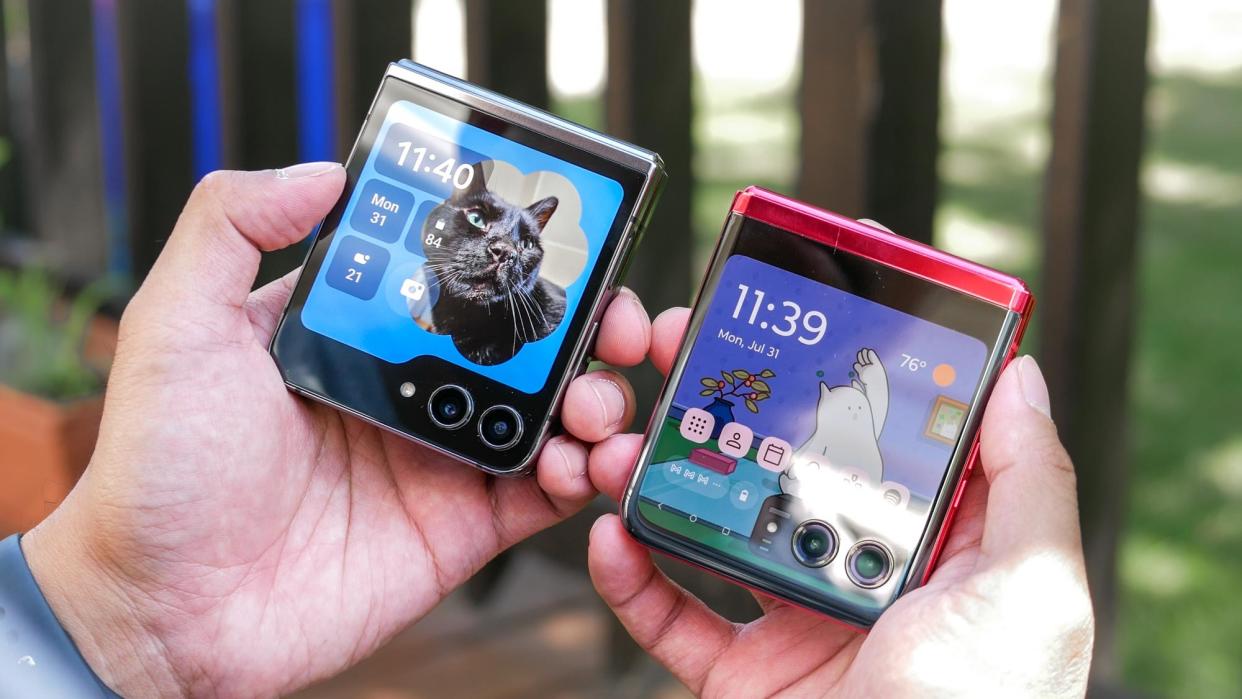

Samsung Galaxy Z Flip 5
A larger Flex Window opens up exciting opportunities
For
Larger, more usable Flex Window
Outstanding camera performance
No gap design
Double the storage
Against
Limited full apps on Flex Windows
Battery life could be better
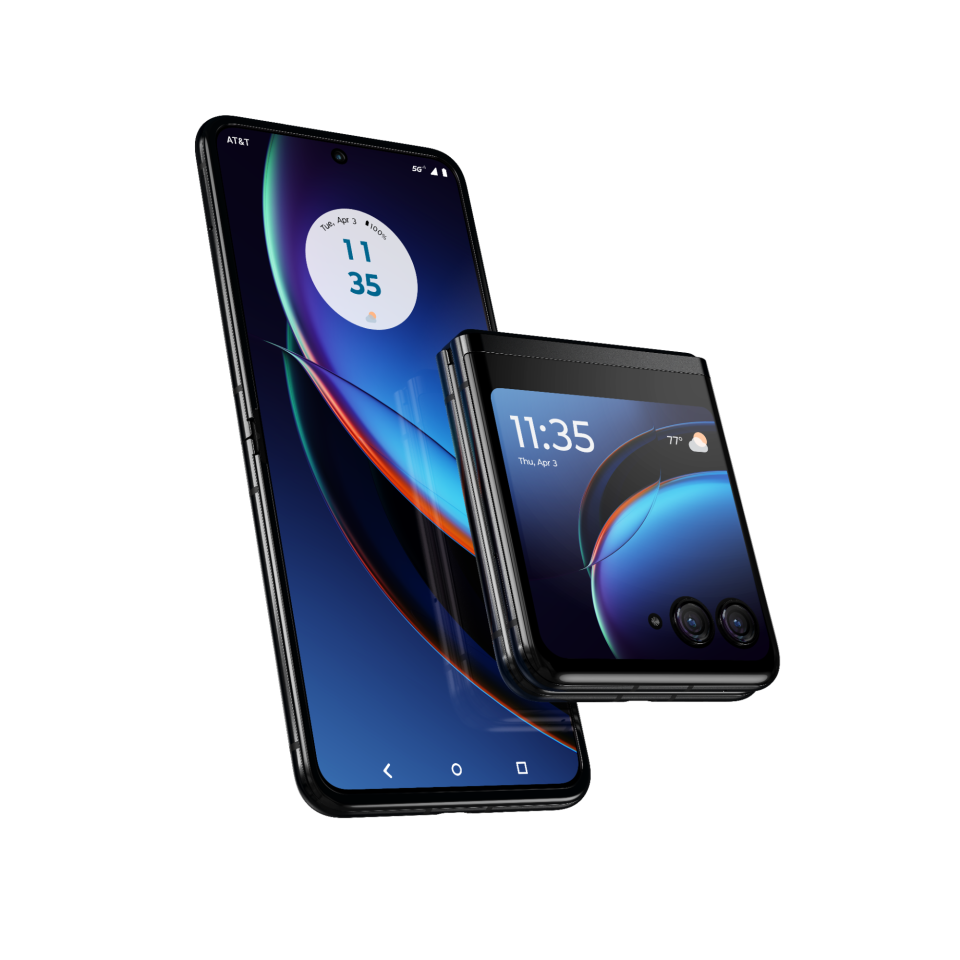
Motorola Razr+
It looks like the third time’s a charm for Motorola.
For
Gorgeous design
Detailed external display
Great for vloggers/content creators
Sharp macro camera
Speedy battery recharge
Against
Underwhelming low-light camera performance
Some apps don’t scale well on external display
A Samsung Galaxy Z Flip 5 vs Motorola Razr+ face-off will help you decide which flip-style foldable is best for you. Yes, Samsung makes some of the best foldable phones around, but this year has been fierce with new entrants challenging its leadership.
Our Galaxy Z Flip 5 review shows how far Samsung has come by growing the cover display while closing the gap when closed. It also offers great cameras. But in my Motorola Razr+ review, I was delighted by how much more refined it was over Motorola's past foldables.
Now that we have a real challenger to Samsung's dominance, we're going to find out which foldable is king. As you'll see in my Samsung Galaxy Z Flip 5 vs Motorola Razr+ comparison, I was shocked by the result.
Samsung Galaxy Z Flip 5 vs. Motorola Razr+: Specs
Samsung Galaxy Z Flip 5 vs. Motorola Razr+: Specs
Samsung Galaxy Z Flip 5 vs. Motorola Razr+: Design
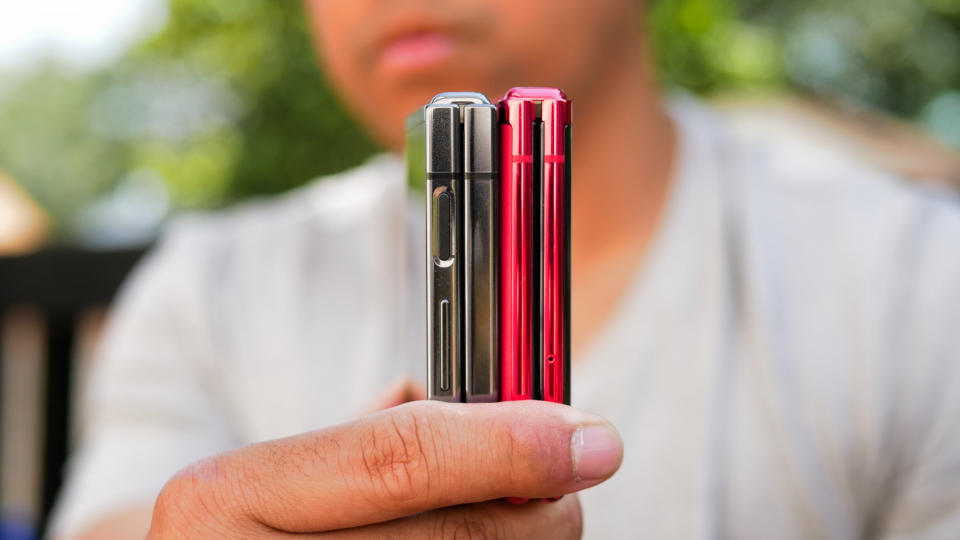
Samsung’s been engineering foldable displays longer than almost everyone else, but we have to give Motorola credit for creating a gapless design with the Razr+. With the new hinge design, the Razr+ left zero room for any gap scrunched in between its inner display when the phone was folded closed. It’s a refinement that some people may not care much about, but nonetheless a noteworthy one that shows how Motorola's design has evolved since the Razr (2019).
Beyond the hinge, the Razr+ is stylish in every way. Aesthetically, I love the contrast of its vegan leather casing paired with its polished metal frame (available on the magenta color). And of course, the Razr+ lives up to its name by sporting a skinny 0.27-inch chassis and 6.63-ounce weight, while making for a premium feel in the hand.
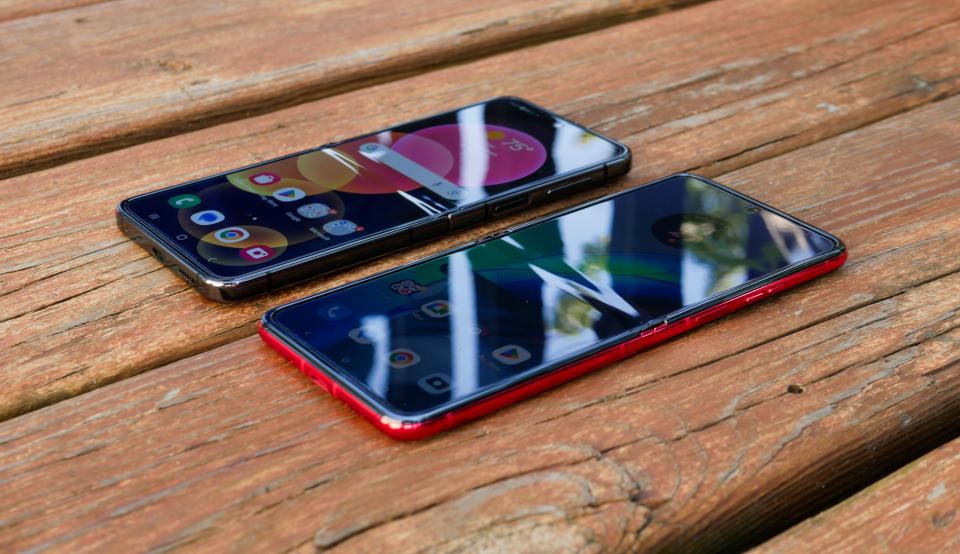
In contrast, Samsung made all the logical changes to Galaxy Z Flip 5’s design. For starters, Samsung's new phone is outfitted with a larger 3.4-inch outer display, which I'll go into more detail below. It results in more functionality out of the phone without the need to open it up, whereas it was limited to just a few widgets and notifications with the Galaxy Z Flip 4.
Furthermore, the Galaxy Z Flip 5 gains the same treatment with a gapless hinge design that makes the two halves of the main inner display flush against each other. It's worth mentioning the IPX8 rating of the Galaxy Z Flip 5, which means it can be submerged under water at a depth of up to 1.5 meters (roughly 5 feet) for up to 30 minutes. The Razr+ has an IP54 rating, giving it protection from dust, but doesn't have submersion protection — only against splashes.
Between the two, the Razr+ feels much better in the hand due to its rounded edges. When I pair that with its more stylish looks and splash resistant construction, it's the phone with the better design.
Winner: Motorola Razr+
Samsung Galaxy Z Flip 5 vs. Motorola Razr+: Displays
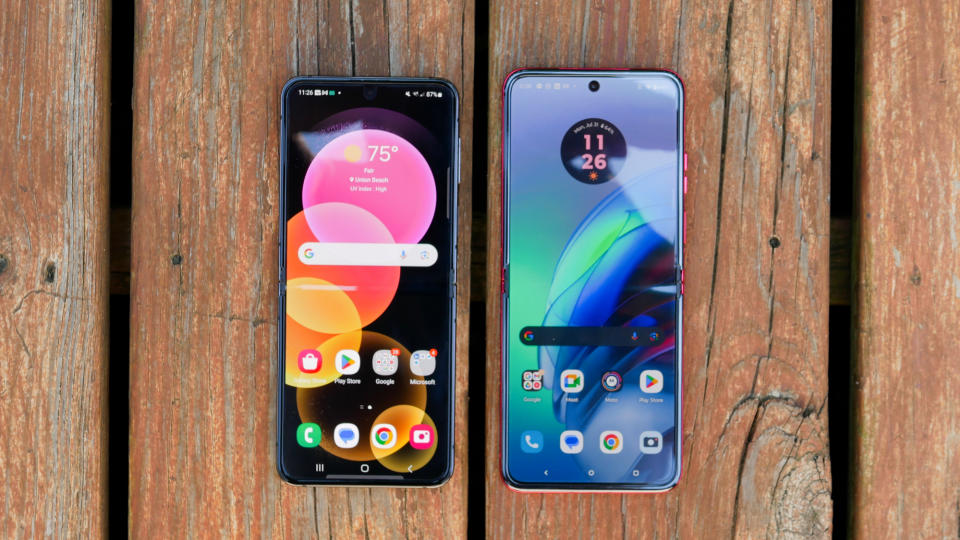
As I've said already, the Samsung Galaxy Z Flip 5 gains a much larger 3.4-inch (720 x 748) Flex Window versus its predecessor. That’s great news, but the Razr+ is packing a larger and more detailed 3.6-inch (1066 x 1056) pOLED external display. Not only is it sharper and more detailed, but I love the added utility it offers with access to all the apps on the Razr+. As a result, I don't always need to open the phone up to use apps.
Of course, Sammy appropriately gave the Flip 5 the same treatment by moving up to a larger outer screen to making it more usable. While this is good news for Samsung’s foldable, there are only a handful of apps that can be accessed with their full experiences. That's an advantage for Motorola's foldable.
As for their main displays, the Galaxy Z Flip 5 is graced with a 6.7-inch FHD+ (2640 x 1080) Dynamic AMOLED 2X display. It's technically more detailed on paper, but it's honestly hard to tell the difference when I look at it against the Razr+'s 6.9-inch FHD+ (2640 x 1080) pOLED display,
Impressively, the Z Flip 5's main display tops out at at a blinding 1,504 nits — a significant boost over the Flip 4's achievement of 772. Even though the Razr+ doesn't reach as high of a mark at 1,084 nits, I still find it usable under direct sunlight.
Winner: Motorola Razr+
Samsung Galaxy Z Flip 5 vs. Motorola Razr+: Software
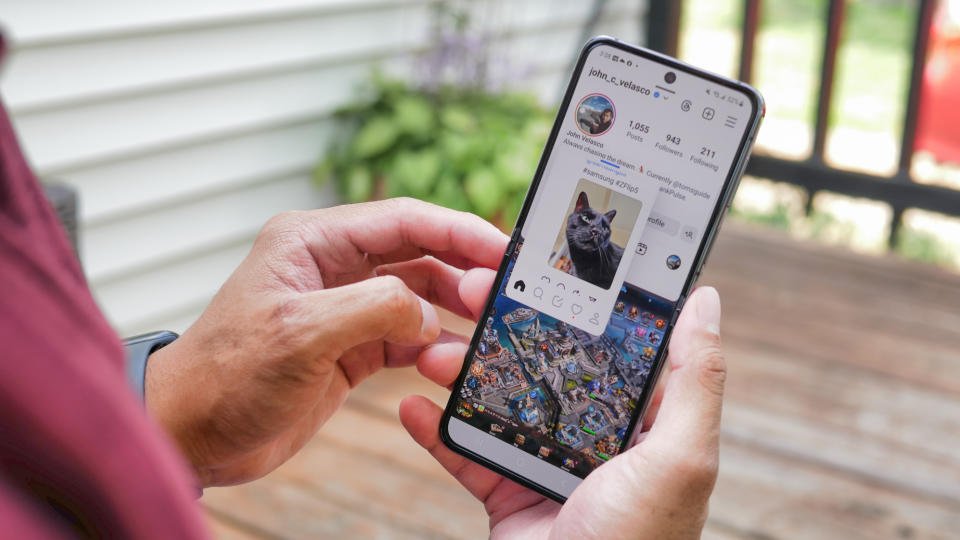
Foldable phones such as these two take pride in being versatile gadgets for a wide range of users. Whether you’re a professional cranking out work, or a content creator putting together a slick Instagram reel, there are plenty of software features that highlight the utility of foldables over your standard slates.
Take for instance the most recent iteration of Samsung’s One UI, which again is accompanied by Flex Mode. It optimizes some of the apps to fit better when the screen is folded — like how the camera app adjusts to make it feel like you were holding a camcorder.
I will admit that I'm surprised by how well these foldables handle multitasking. In fact, you can run upwards of three apps simultaneously with both. Sure, the implementation is different at initiating them, but I'm able to have two apps running side-by-side, while a third app is open in its own separate floating window.
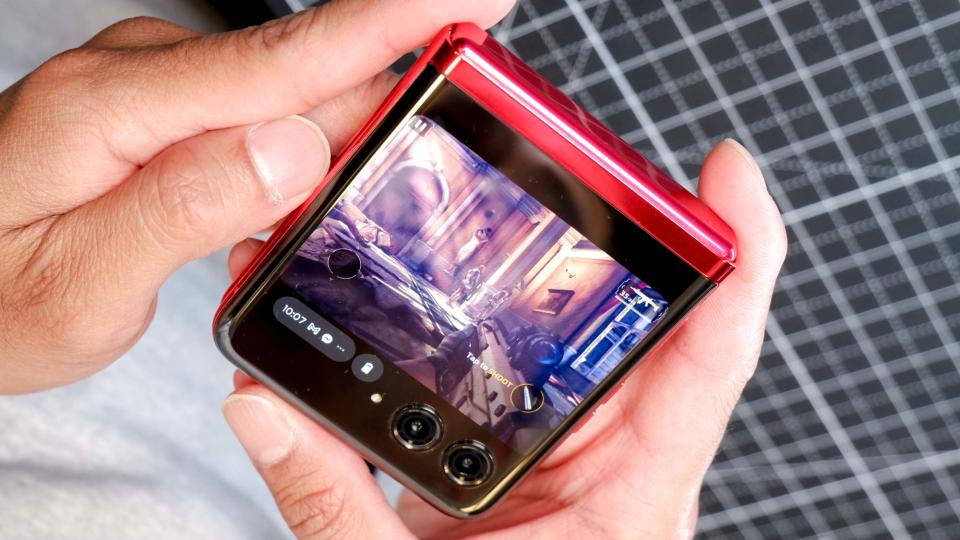
Motorola’s interpretation is no different on the Razr+ with its “Flex View” mode. You could argue that Motorola just ripped what Samsung did, but the Razr+ is packaged with the same handy gestures I've seen countless times on Moto's phones. For example, the chopping gesture to turn on the LED flash, or the double twist motion to launch the camera app at any time. They're simple and useful, and I love them.
Samsung’s Android update policy is one of the best in the industry, with four years of Android software updates and five years of security patches. It essentially means you’ll get more life out of the upcoming Samsung Galaxy Z Flip 5 with four years of Android software updates compared to Motorola’s commitment of three years.
The deciding factor in all of this is how the Razr+'s outer screen offers support for all apps. This ability to run full apps without opening the phone comes in handy, while being less demanding of the battery at the same time.
Winner: Motorola Razr+
Samsung Galaxy Z Flip 5 vs. Motorola Razr+: Cameras
Samsung Galaxy Z Flip 5 vs. Motorola Razr+: Cameras
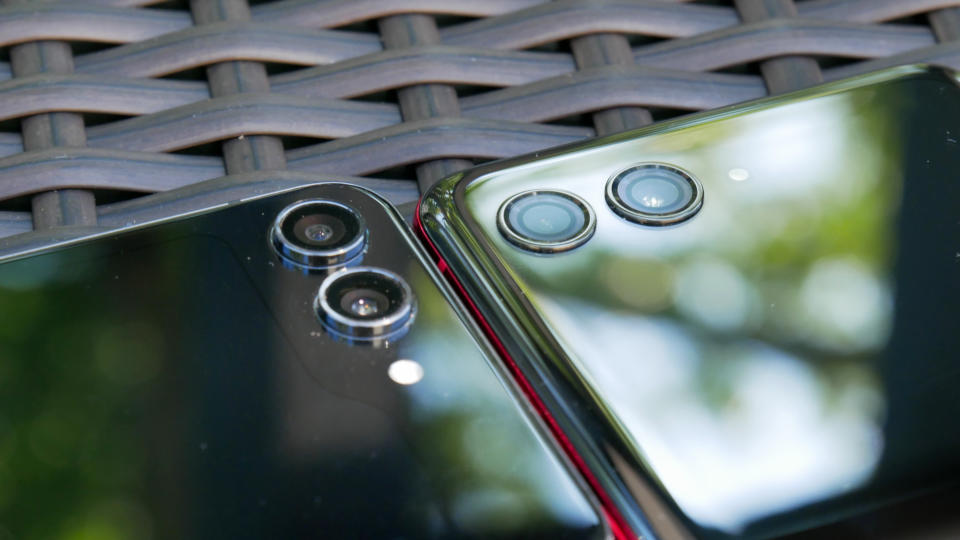
When it comes to quality, you can bet that Samsung won’t disappoint. That’s because after we pitted the Motorola Razr+'s dual cameras (12MP main + 13MP ultrawide) against last year’s Samsung Galaxy Z Flip 4, we found out that Samsung’s foldable phone still had the superior cameras.
The Galaxy Z Flip 5 maintains the same dual-camera setup as its predecessor, a 12-megapixel f/1.8 main camera and a 12-megapixel ultra wide angle f/2.2 camera, but leverages an AI-powered image signal processing (ISP) algorithm to optimize photos. This resultw in giving the Galaxy Z Flip 5 more of an edge, particularly under low light — an area where the Motorola Razr+ struggled, which you'll see farther below.
I also prefer the camera app of the Z Flip 5, mainly for its manual video controls and a portrait video mode as well. The average person may not use these modes as much as some of the other staple ones, like portrait or panorama, but having them gives the Z Flip 5 the extra utility I crave being a videographer.
Let me start off with the quality from their main cameras. As you can see in the comparison photo above, the Razr+ tends to be a little more over-exposed under the same conditions. The highlights are particularly overblown. In contrast, the Flip 5 offers better dynamic range performance by toning down the highlights for a more realistic look.12MP main (f/1.5), 13MP ultrawide (f/2.2)
I can say the same after switching over to their respective wide-angle cameras. Not only is the dynamic range performance better on the Flip 5, but you can also see how its wider 123-degree field of view captures more of the scene over the Razr+'s narrower 108-degree field of view.
There's more of a disparity with their low-light performances, which is an easy win for the Galaxy Z Flip 5. Using their respective night modes, you can visibly see how the Flip 5 produces a brighter image with more detail and color with the photo above. Unfortunately, the Razr+ can't compare with its dimmer composition and muddy visuals.
I also like how the Flip 5 handles portrait mode better by properly detecting the edges of a face and applying the correct amount of bokeh to the background. The Razr+ is flawed only by its weaker dynamic range, which you can see in the stripe pattern of the shirt and how it's over-exposed.
Since I'm able to use their external screens for selfies, I would recommend using their main cameras for selfies. However, if you should still want to use their front-facing cameras, they both deliver decent results.
The Galaxy Z Flip 5 favors a warmer look, which you can see adds a yellowish hue to my colleague's selfie above. The Razr+ produces good results too, but I can tell that it's just a smidge softer in tone.
One area where I find the Razr+ better than the Flip 5 is whenever I take closeup or macro photos. That's because it has a dedicated macro mode that lets me get really close to objects, all while capturing sharp details in the process. For example, you can easily make out the sharp edges of the flower in the Razr+'s macro shot.
Winner: Samsung Galaxy Z Flip 5
Samsung Galaxy Z Flip 5 vs. Motorola Razr+: Performance
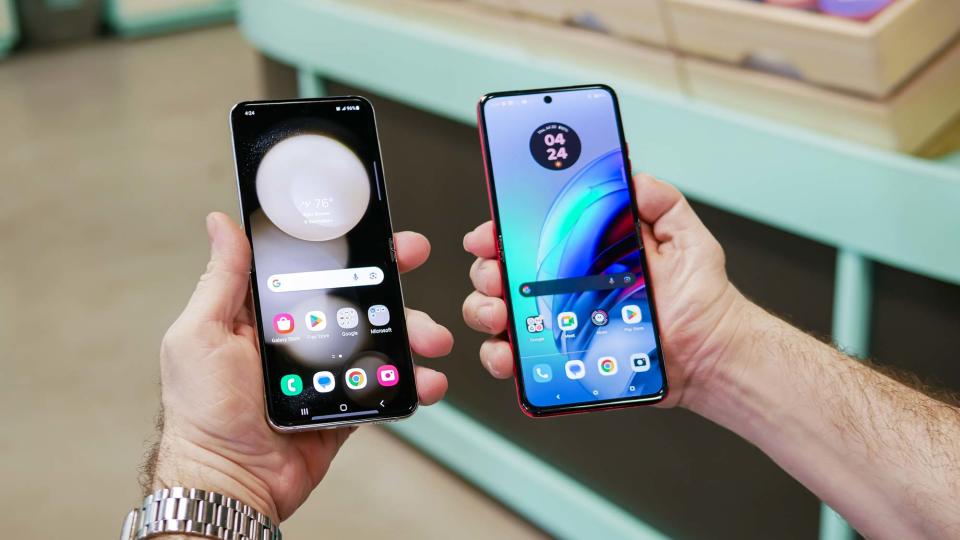
Being the newer smartphone, the Samsung Galaxy Z Flip 5 has an edge when it comes to raw power. That’s because the Motorola Razr+ is running the Snapdragon 8 Plus Gen 1, while the Galaxy Z Flip 5 is powered by the newer Snapdragon 8 Gen 2 — the same chip that powers the Galaxy S23 line from earlier this year, which inherently gives Samsung the edge here.
As you can see in the chart below, the Galaxy Z Flip 5 easily defeated the Razr+ in a few key benchmark tests. In GeekBench 5, the Flip 5 pulled in scores of 1,354 and 4,288 for the single-core and multi-core tests. Meanwhile, the same test running on the Razr+ produced scores of 1,320 and 4,134. It's not a substantial difference quite honestly, but it still shows the Flip 5's superior processing performance.
However, that doesn’t paint as complete of a picture, considering that the Razr+ handled everything we threw at it with ease in our review, despite running a processor first announced in 2022. With everyday functions, I didn't find one phone to be vastly more responsive than the other for opening apps, surfing the web, and occasionally playing a mobile game.
Winner: Samsung Galaxy Z Flip 5
Samsung Galaxy Z Flip 5 vs. Motorola Razr+: Battery life
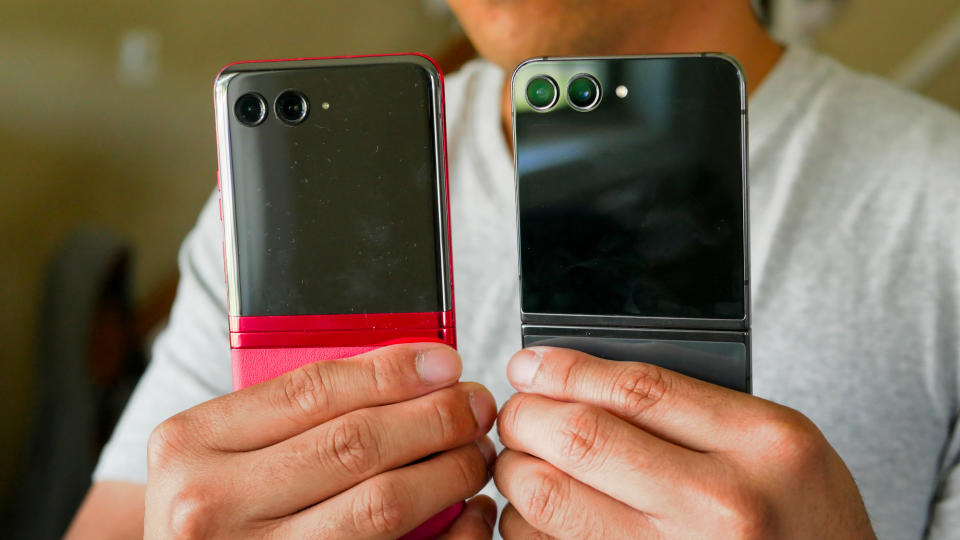
I really thought there would be a leap in battery life for the Flip 5. While it's nonetheless an improvement over its predecessor, the Flip 5 reached a mark of 9 hours and 53 minutes in Tom's Guide battery benchmark test — which is nearly a full hour better than the Z Flip 5. There's no denying the power efficiency of the Snapdragon 8 Gen 2, but I was hoping for a more dramatic boost.
That's because the Motorola Razr+ still produced a longer battery life at 10 hours and 9 minutes. It does benefit from having a larger 3,800 mAh battery, so I bet that the Flip 5 could've eclipsed it if it had a larger battery.
Nevertheless, it's a win for Motorola, which is made more poignant with my real world usage. On average, the Razr+ had about 20% battery left in the tank before bedtime, while the Flip 5 got me to the 15% mark.
When it comes to recharging them, the Razr+ offers the speedier 30W wired charging. It got to 35% after 15 minutes of charging, followed by 66% after 30 minutes. I'm still running the recharge test for the Z Flip 5, but it has so far yielded 21% after 15 minutes of charging with a 20W charger. To be fair, it should charge faster than that because it supports 25W wired charging.
Winner: Motorola Razr+
Samsung Galaxy Z Flip 5 vs. Motorola Razr+: Verdict
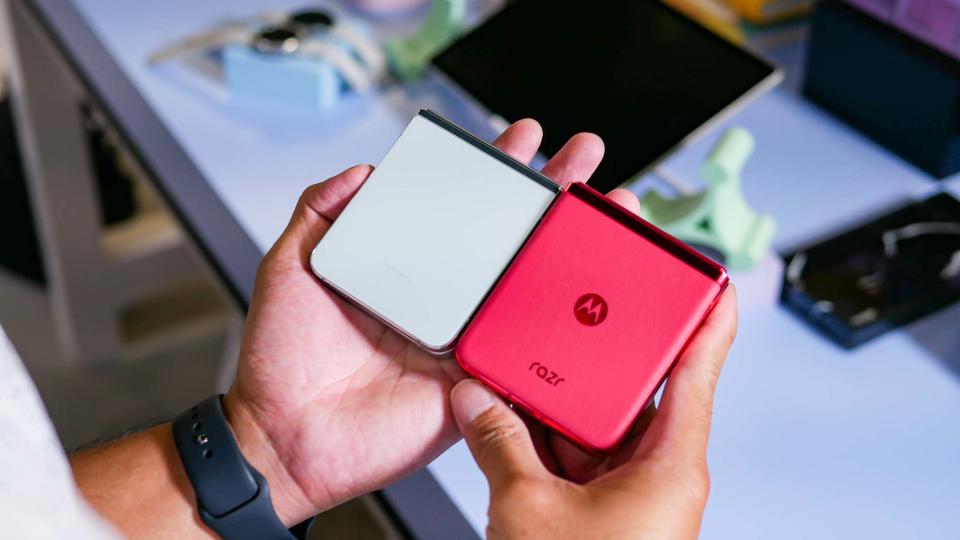
I think we've finally established what clamshell foldable phones are all about, and these two exemplify them. No longer are they just novelties that fold up into smaller form factors, but rather, the Samsung Galaxy Z Flip 5 and Motorola Razr+ proves that these devices have extra functionality you won't find in even some of the best smartphones.
Both are priced at $999, but after dueling it out in various categories, I believe that the Razr+ pulls ahead in this head-to-head comparison against the Z Flip 5. Even though it's hard for me to overlook the fact that it has the inferior cameras, it's still a very capable camera phone when the conditions are ripe.
What really seals it for me is the extra functionality of its outer screen, more attractive design, and longer battery life. It really sets the benchmark for what I expect out of clamshell foldable phones going forward. Given all the setbacks of its previous efforts, this is a satisfying, long overdue win for Motorola.
Winner: Motorola Razr+

